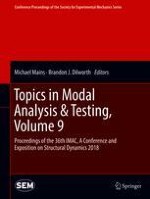2019 | Book
Topics in Modal Analysis & Testing, Volume 9
Proceedings of the 36th IMAC, A Conference and Exposition on Structural Dynamics 2018
Editors: Dr. Michael Mains, Brandon J. Dilworth
Publisher: Springer International Publishing
Book Series : Conference Proceedings of the Society for Experimental Mechanics Series
